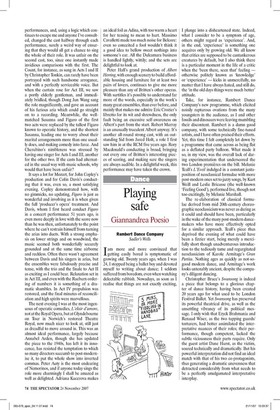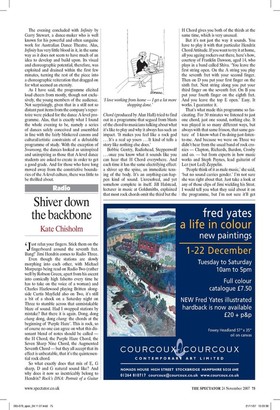Playing safe
Giannandrea Poesio Rambert Dance Company Sadler's Wells Tam more and more convinced that getting easily bored is symptomatic of growing old. Twenty years ago, when I was 24, I stopped being a ballet boy and devoted myself to writing about dance; I seldom suffered from boredom, even when watching delectable rubbish. Nowadays, as soon as I realise that things are not exactly exciting, I plunge into a disheartened state. Indeed, what I consider to be a symptom of age, others might regard as 'experience'. And, in the end, 'experience' is something one acquires only by growing old. We all know that critics are supposed to be cantankerous creatures by default, but I also think there is a particular moment in the life of a critic when the 'been there, seen that' feeling — otherwise politely known as 'knowledge' or 'experience' — kicks in unmercifully, no matter that I have always hated, and still do, the 'in the old days things were much better' attitude.
Take, for instance, Rambert Dance Company's new programme, which elicited noisily rapturous ovations from the many youngsters in the audience, as I and other fossils and dinosaurs were leaving mumbling their discontent. Rambert is a damn good company, with some technically fine-tuned artists, and I have often praised their efforts. Yet, this time I felt completely let down by a programme that came across as being flat as a deflated party balloon. What made it so, in my view, was the overall lack of daring experimentation that underscored the two London premieres on the bill. Melanie Teall's L'Eveil indulged in a constant juxtaposition of neoclassical formulae with more post-modern ones set to jazzy songs, by Kurt Weill and Leslie Bricusse (the well-known 'Feeling Good'), performed live, though not too excitingly, by Melanie Marshall.
The re-elaboration of classical formulae derived from mid 20th-century choreographic neoclassicism was never as daring as it could and should have been, particularly in the wake of the many post-modern dancemakers who have more effectively opted for a similar approach. Teall's piece thus deprived the evening of what could have been a fizzier start, being merely a mercifully short though unadventurous introduction to the tediously tame and regurgitated neoclassicism of Karole Armitage's Gran Partita. Nothing ages as quickly as not-sogood modern dance, and Armitage's work looks untenably ancient, despite the company's diligent dancing.
Christopher Bruce's Swansong is indeed a piece that belongs to a glorious chapter of dance history, having been created 20 years ago for what used to be London Festival Ballet. Yet Swansong has preserved its powerful theatrical drive, as well as the unsettling vibrancy of its political message. I only wish that Eryck Brahmania and Renaud Wiser, as the two tapping guards/ torturers, had better assimilated the interpretative nuances of their roles; their performance, though competent, lacked the subtle viciousness their parts require. Only the guest artist Dane Hurst, as the victim, soared technically and dramatically. But his powerful interpretation did not find an ideal match with that of his two co-protagonists, thus generating a dramatic unevenness that detracted considerably from what needs to be a perfectly amalgamated interpretative interplay.
The evening concluded with Infinity by Garry Stewart, a dance-maker who is well known for his powerful and often sanguine work for Australian Dance Theatre. Alas, Infinity has very little blood in it, in the same way as it does not seem to have much of an idea to develop and build upon. Its visual and choreographic potential, therefore, was exploited and drained within the first few minutes, turning the rest of the piece into a choreographic reiteration that dragged on for what seemed an eternity.
As I have said, the programme elicited loud cheers from mostly, though not exclusively, the young members of the audience. Not surprisingly, given that in a still not so distant past items from the company's repertoire were picked for the dance A-level programme. Alas, that is exactly what I found the whole evening to be, namely a series of dances safely conceived and assembled in line with the fairly blinkered canons and cultural/artistic constraints of a debatable programme of study. With the exception of Swansong, the dances looked as uninspired and uninspiring as those that A-level dance students are asked to create in order to get a good grade. And for those who have long moved away from the constrictive boundaries of the A-level culture, there was little to be thrilled about.







































































 Previous page
Previous page